Table of contents
- Kawasaki in the 2020 model year Compressor bike Z H2 new included
- Some new model variants and numerous updates
- Kawasaki Ninja 125
- Kawasaki Z 125
- Kawasaki J 125
- Kawasaki J 300
- Kawasaki Versys-X 300
- Kawasaki Ninja 400
- Kawasaki Z 400
- Kawasaki Ninja ZX-6R / KRT
- Kawasaki Ninja 650
- Kawasaki Z 650
- Kawasaki Versys 650
- Kawasaki Vulcan S.
- Kawasaki W 800 / Street / Cafe
- Kawasaki Z 900/70 kW
- Kawasaki Z 900 / RS
- Kawasaki Z H2
- Kawasaki Ninja H2 / Carbon
- Kawasaki Ninja H2 SX / SE / SE+
- Kawasaki Ninja ZX-10R KRT Replica / SE / RR
- Kawasaki Versys 1000 / SE / Grand Tourer
- Kawasaki Ninja 1000 SX
- Kawasaki Z 1000 / R Edition
- Kawasaki ZZR 1400
- Kawasaki in model year 2020 – prices
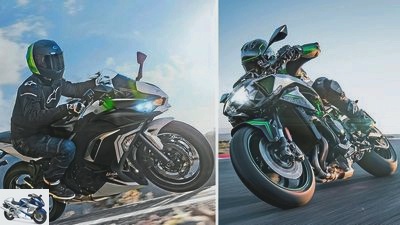
Kawasaki.
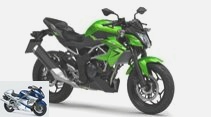
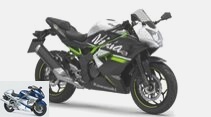
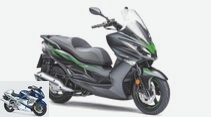
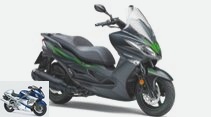
23 pictures
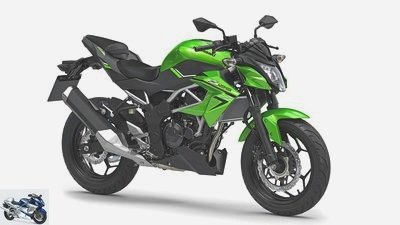
Kawasaki.
1/23
Kawasaki Z 125. Price: from 3,995 euros.
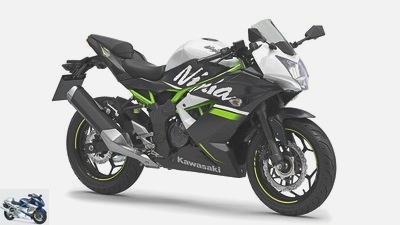
Kawasaki.
2/23
Kawasaki Ninja 125. Price: from 4,295 euros.
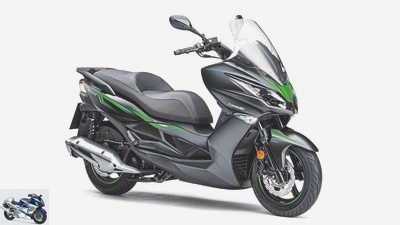
Kawasaki.
3/23
Kawasaki J 125. Price: from 4,745 euros.
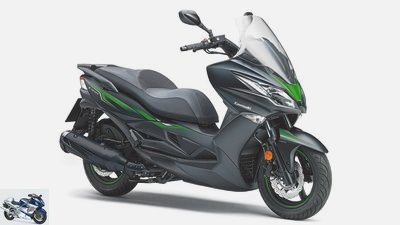
Kawasaki.
4/23
Kawasaki J 300. Price: from 5,695 euros.
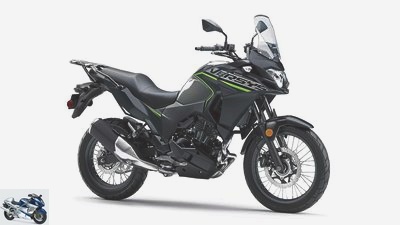
Kawasaki.
5/23
Kawasaki Versys-X 300. Price: from 5,795 euros.
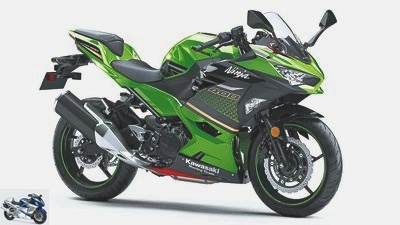
Kawasaki.
6/23
Kawasaki Ninja 400. Price: from 6,295 euros.
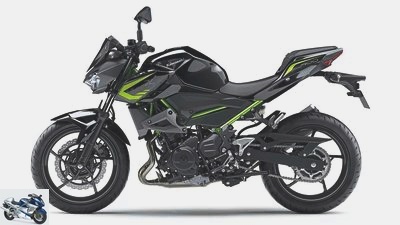
Kawasaki.
7/23
Kawasaki Z 400. Price: from 5,695 euros.
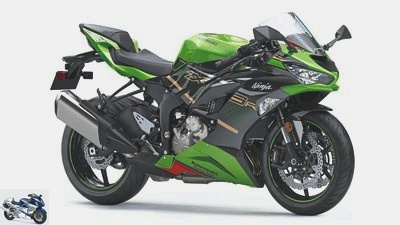
Kawasaki.
8/23
Kawasaki Ninja ZX-6R. Price: from 11,695 euros Kawasaki Ninja ZX-6R KRT. Price: from 11,895 euros.
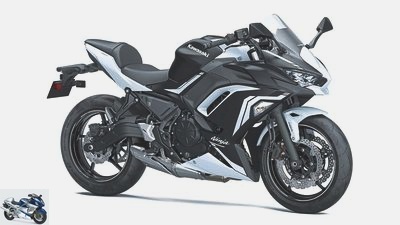
Kawasaki.
9/23
Kawasaki Ninja 650. Price: from 7,495 euros.
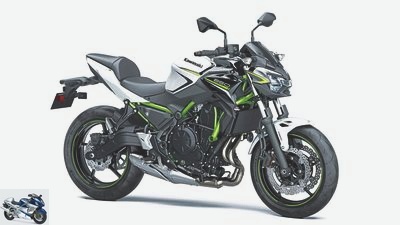
Kawasaki.
10/23
Kawasaki Z 650. Price: from 6,995 euros.
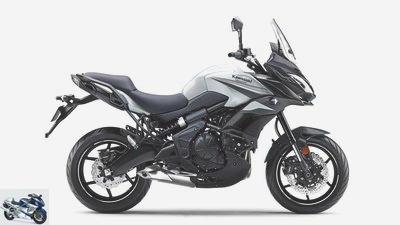
Kawasaki.
11/23
Kawasaki Versys 650. Price: from 8,145 euros.
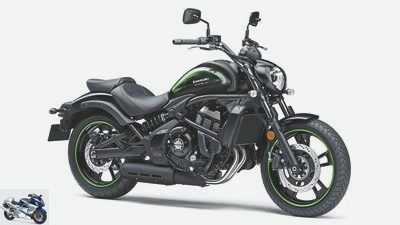
Kawasaki.
12/23
Kawasaki Vulcan S. Price: from 7,745 euros.
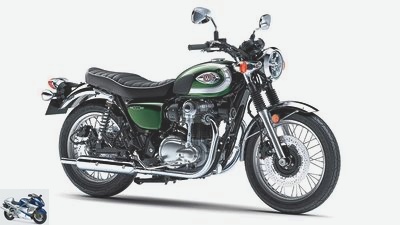
Kawasaki.
13/23
Kawasaki W 800. Price: from 9,995 euros Kawasaki W 800 Street. Price: from 9,795 euros Kawasaki W 800 Cafe. Price: from 10,595 euros.
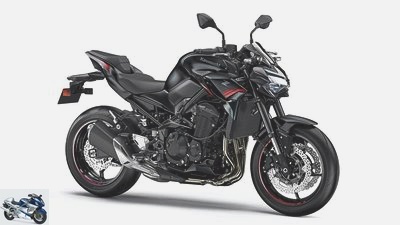
Kawasaki.
14/23
Kawasaki Z 900. Price: from 9,495 euros Kawasaki Z 900 “70 kW”. Price: from 9,495 euros.
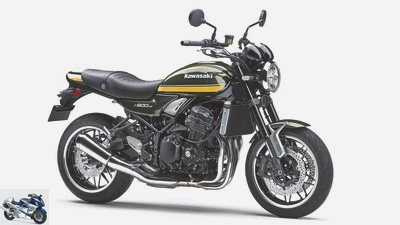
Kawasaki.
15/23
Kawasaki Z 900 RS. Price: from 11,695 euros Kawasaki Z 900 RS Cafe. Price: from 12,295 euros.
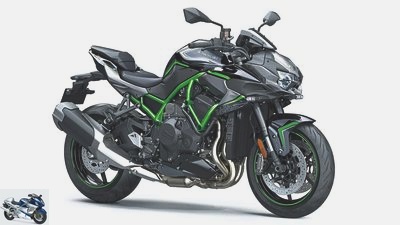
Kawasaki.
16/23
Kawasaki Z H2. Price: from 17,095 euros.
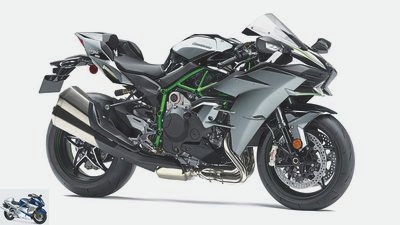
Kawasaki.
17/23
Kawasaki Ninja H2. Price: from 29,500 euros Kawasaki Ninja H2 Carbon. Price: from 32,500 euros.
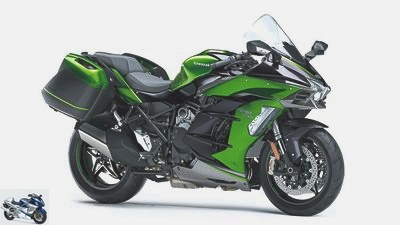
Kawasaki.
18/23
Kawasaki Ninja H2 SX. Price: from 18,995 euros Kawasaki Ninja H2 SX SE. Price: from 22,095 euros Kawasaki Ninja H2 SX SE +. Price: from 25,195 euros.
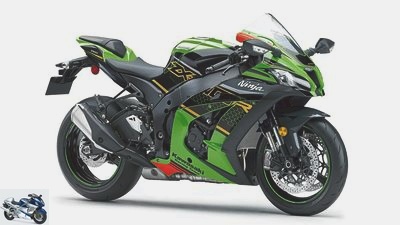
Kawasaki.
19/23
Kawasaki Ninja ZX-10R KRT Replica. Price: from 17,695 euros Kawasaki Ninja ZX-10R SE. Price: from 22,995 euros Kawasaki Ninja ZX-10R RR. Price: from 25,995 euros.
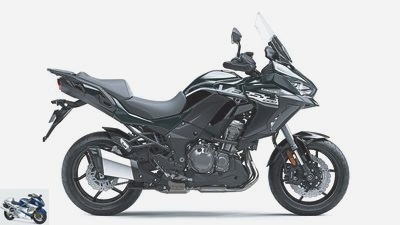
Kawasaki.
20/23
Kawasaki Versys 1000. Price: from 13,095 euros Kawasaki Versys 1000 SE. Price: from 16,595 euros Kawasaki Versys 1000 Grand Tourer. Price: from 15,545 euros (SE variant: from 18,945 euros).
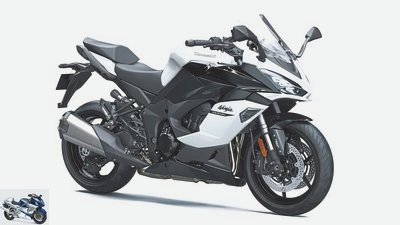
Kawasaki.
21/23
Kawasaki Ninja 1000 SX. Price: from 13,745 euros.
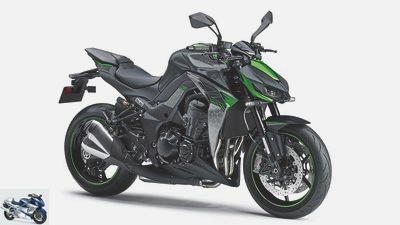
Kawasaki.
22/23
Kawasaki Z 1000. Price: from 12,595 euros Kawasaki Z 1000 R Edition. Price: from 14,095 euros.
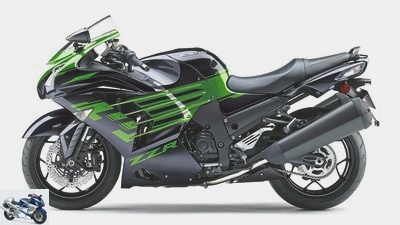
Kawasaki.
23/23
Kawasaki ZZR 1400. Price: from 16,395 euros.
motorcycles
Kawasaki in the 2020 model year
Kawasaki in the 2020 model year
Compressor bike Z H2 new included
The most striking innovation from Kawasaki in the 2020 model year is the Z H2. As an offshoot of the compressor-operated H2 models, it will in future be part of the most powerful Power Nakeds. There is also a new addition to the W-800 family. An overview.
Volkmar Jacob
01/28/2020
In 2019, it was very close to ranks two to four in the registration statistics. Behind the clear market leader BMW and the convincingly second-placed MT-07 from Yamaha, Kawasaki, Honda and KTM fought for third place until the end. Ultimately, the Z 900 from Kawasaki but secured third place. A Kawasaki motorcycle followed in fourth position with the Z 650, followed by the Honda Africa Twin and the KTM 790 Duke.
Some new model variants and numerous updates
In addition to the Z H2, Akashi created another offshoot of existing models with the W 800. Their styling is strongly reminiscent of the first W, which still rolled off the assembly line as the 650 back then. Unlike the Street and Cafe versions, the new one has no name affix. The Greens put a lot of detailed work into the aforementioned top sellers Z 900 and Z 650 as well as the newly styled mid-range athlete Ninja 650.
In unison, they received a TFT display with smartphone connectivity, complete LED lighting and other standard tires. The 900 also donated Kawasaki traction control and various driving modes. The name Z 1000 SX of the sports tourer changes to Ninja 1000 SX. This bike also received a technical update.
Kawasaki Ninja 125
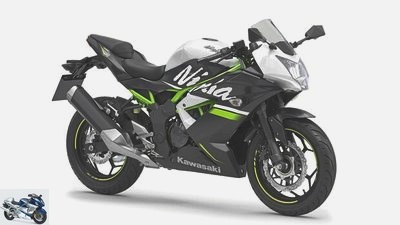
Kawasaki.
Kawasaki Ninja 125.
It was about time: after what felt like an eternity, Kawasaki has finally been offering two real alternatives for the young and the young at heart with an A1 driver’s license in the hotly contested, still very popular 125cc segment since the beginning of 2019. The little ninja scores with Kawa-typical, sporty virtues: sharp optics, firm chassis, good brakes. If the worst comes to the worst, the ABS also regulates at short intervals – good for short braking distances. The low consumption is a great everyday benefit. On the country road it is content with a meager 3.2 liters per 100 kilometers, in combination with the 11 liter tank, ranges of 300 kilometers can easily be achieved. The little athlete is also available as a performance version. The package includes, for example, an Arrows muffler and a cover for the pillion seat. 2020 colors: green-black, black, white-black.
Kawasaki Z 125
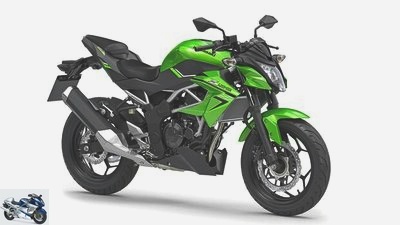
Kawasaki.
Kawasaki Z 125.
The Z 125 has been the naked Kawasaki variant in the 125cc entry-level class since 2019. Technically, it is almost identical to the little ninja. With its angular shapes, the tubular space frame and the distinctive lamp mask, it is stylistically based on its big Zett sisters. In the 125cc registration statistics, it landed in seventh place in 2019 and has thus established itself very well.
Kawasaki J 125
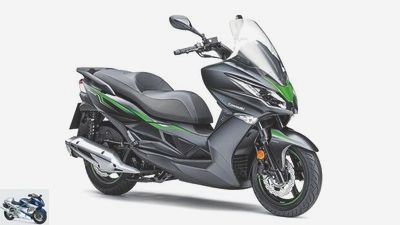
Kawasaki.
Kawasaki J 125.
As with its big brother, the J 300, the technology of the 125cc racer comes from the Taiwanese manufacturer Kymco, and, as with the 300cc, the styling was done by Kawasaki. The dynamic shapes and the green painted surfaces on the cladding are clear Kawa features. In 2020, the light scooter is rolling into its fourth season, the manufacturer has not made any changes – in visual or technical terms.
Kawasaki J 300
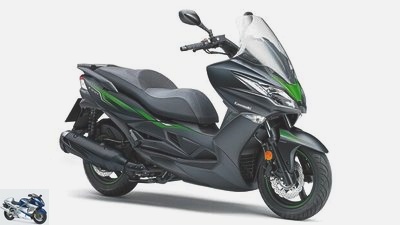
Kawasaki.
Kawasaki J 300.
The technical basis of the only Kawasaki scooter over 125 cubic centimeters is the Downtown 300i from the Taiwanese manufacturer Kymco. The design of the J 300 comes from Kawasaki itself. The only technical change since its debut in 2014 concerns the conversion to the Euro 4 standard for the 2018 model year. Tried and tested Kymco technology combined with typically aggressive Kawa style – that fits. For 2020, the 28 hp scooter is only available in the color combination black and green.
Kawasaki Versys-X 300
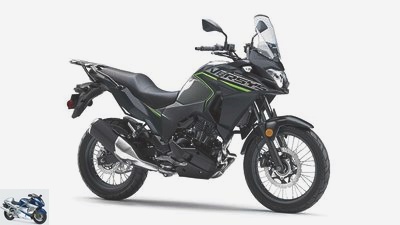
Kawasaki.
Kawasaki Versys-X 300.
In 2020, Kawasaki will only have the standard version of the little adventurer in its range. The “Urban” with main stand, hand protectors, top case and tank pad is no longer necessary. The Versys-X 300 has remained the lively 300 twin-cylinder. He loves high speeds, but vibrates quite clearly. Versys’ particular strengths: plenty of space for driver and front passenger, high level of everyday use, good equipment, long range. The low consumption in combination with the 17-liter fuel drum makes stopping at the tank seldom.
Kawasaki Ninja 400
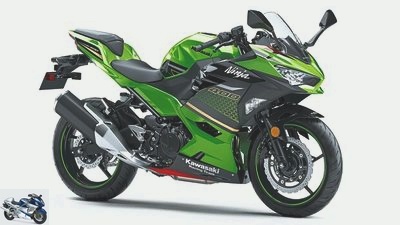
Kawasaki.
Kawasaki Ninja 400.
The whirlwind in this class pleases with the most playful handling, top brakes and the best driving performance. For this, the lively 399 cubic twin needs high speeds, the two pistons zoom up and down up to 12,000 times per minute. The design was typically Kawa aggressive, it underlines the sporty touch of the little ninja. Nevertheless, it is also suitable for everyday use. Proofs? Here you go: good light, great wind protection, great view in the rear-view mirrors, high payload, low weight.
Kawasaki Z 400
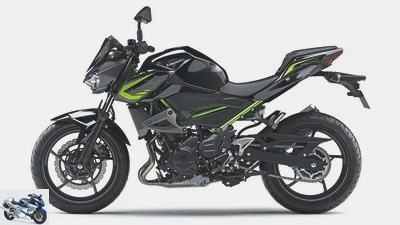
Kawasaki.
Kawasaki Z 400.
Even seasoned testers with a high affinity for supersport get weak with the little Zett. They praise the firm, but only moderately appealing chassis and the high cornering stability. Sharpening curves makes you even more fun. The engine, identical to that of the Ninja 400, also pleases with a lot of character and liveliness. Its 45 hp are sufficient for everyday use, and the Z cuts a fine figure on the home route too. Driving the Z 400 means having a lot of fun for little money.
Kawasaki Ninja ZX-6R / KRT
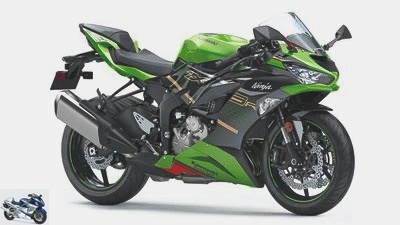
Kawasaki.
Kawasaki Ninja ZX-6R.
Fans of super sporty 600s were excited about the new ZX-6R at the beginning of 2019. Until then, the Yamaha R6 was the only bike in this class for years. Unlike in the past, when Kawasaki also had a version with 599 cc in its range, the new six will only be launched with 636 cc. With the increase in displacement, the suitability for everyday use grew, and the shorter gear ratio created additional dynamism. It is easy to get over the fact that the new six no longer fits into any racing class.
Kawasaki Ninja 650
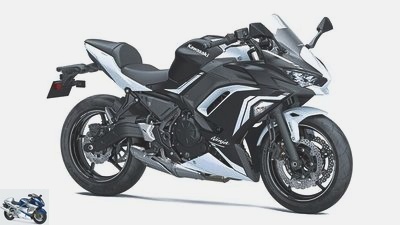
Kawasaki.
Kawasaki Ninja 650.
With the newly styled cladding, the curved, narrower pane and the sharper-cut headlights (LED technology), the mid-range ninja looks more dynamic and sporty. The exhaust with a shorter rear silencer was also designed differently; Inside, the exhaust gases are now cleaned by a catalytic converter with a larger volume. The Kawasaki is the first machine in the 650 class to have a TFT display. It measures 4.3 inches and can be connected to a smartphone. Colors: green / black, black, white-black.
Kawasaki Z 650
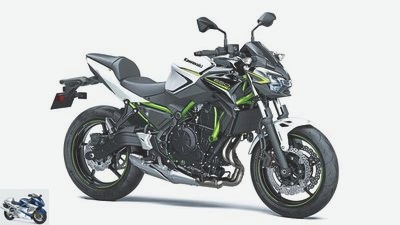
Kawasaki.
Kawasaki Z 650.
Like its bigger sister, the Z 900, the mid-range athlete Ninja 650 and the sports tourer Ninja 1000 SX, Kawasaki also features the 4.3-inch, informative TFT display with connectivity function for the 650. Other changes: complete LED lighting, more comfortable passenger seat, new series tires (Dunlop Roadsport 2). When it was first served in 2017, the mid-range naked garnered a lot of applause and immediately became the brand’s top seller. In addition, it was ranked three of the best-selling motorcycles in the registration statistics. Still extremely popular, it was in fourth place in 2019, directly behind the Z 900. Its 68 hp in-line two-cylinder gives the Zett a lively dynamic, although fine vibrations naturally accompany the journey through the speed range of the counter-rotating machine. As the handiest in its class, it has become a star on the curve, and thanks to the comparatively low seat height and tight knees, even people without a guard can find their way around the 650 straight away.
Kawasaki Versys 650
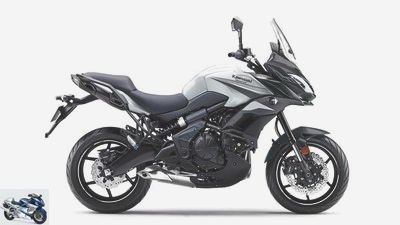
Kawasaki.
Kawasaki Versys 650.
The strut bolted to the side makes it clear that the 650 Versys is still based on the old ER-6 models. This does not restrict them in their determination, namely to eat kilometers as comfortably as possible, but in no way. Lots of space for driver and front passenger, proper wind protection and the 21-liter tank combined with low consumption make long stages possible. Despite its long suspension travel of 150 millimeters at the front and 145 at the rear, it is purely a street motorcycle. Terrain? D rather not.
Kawasaki Vulcan S.
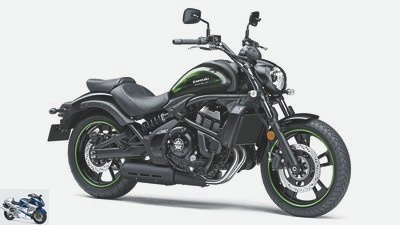
Kawasaki.
Kawasaki Vulcan S..
Since its debut in 2015, the Vulcan has been the best-selling chopper in Germany. An exception was 2016, when it was ranked third behind two Harleys. Its low seat height of just 705 millimeters and the comparatively low price are strong arguments in favor of the Vulcan. Despite its typical chopper geometry – long wheelbase, flat steering head angle, large caster – it can be driven very neutrally. In addition, the long-running hit offers effective brakes and responsive spring elements.
Kawasaki W 800 / Street / Cafe
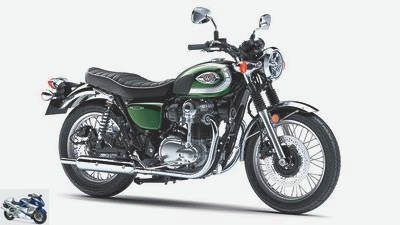
Kawasaki.
Kawasaki W 800.
After two years without a W-800 model, Kawasaki put the two retro bikes Street and Cafe in the shop windows of dealerships in 2019. With the W 800 (without name affix), another version now completes the range. Stylistically, it is reminiscent of the origins of the W series, which began in 1999 with the 650 and was continued with the 800 version in 2011. In 2016, Kawa temporarily discontinued the charming classic. The new one has a lot more chrome sparkles than the previous versions, and the engine also looks friendlier thanks to the polished side covers and a little silver color. In all models, the in-line two-cylinder with a displacement of 773 cubic centimeters and an output of 48 hp works uniformly. The Twin 2020 does not (yet) meet the Euro 5 standard. The biggest technical difference to the street and cafe is the size of the front wheel, which measures 19 instead of 18 inches. In addition, the handlebar should position the driver between the classic upright sitting position of the street and the forward-leaning seating position of the cafe.
Kawasaki Z 900/70 kW
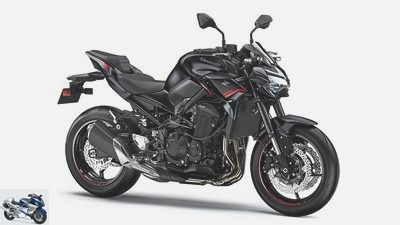
Kawasaki.
Kawasaki Z 900.
When the Z 900 was launched in 2017, it was criticized for the lack of electronic driver assistance. This is over now, because Kawasaki has given the brand’s top seller traction control and four driving modes. The electronics also offer two power modes for different throttle response / power delivery. Like the two 650s athletes – Ninja and Z – the 900s also has the 4.3-inch TFT display including a Bluetooth connection for the smartphone. In addition, the Greens are switching the lighting completely to LED. To make room for new catalytic converters, Kawasaki modified the exhaust system – Euro 5 sends its regards. Instead of the Dunlop D 214 in the special specification “Z”, the Roadsport 2 of the same brand is used on the naked bike. For owners of the A2 driver’s license there will be a 48 hp version again in the future. As an accessory, the manufacturer offers, among other things, a 12-volt socket that is attached under the seat. All in all, the € 400 surcharge compared to the previous year is absolutely justified.
Kawasaki Z 900 / RS
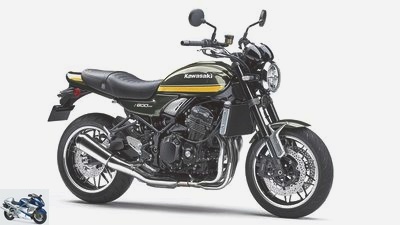
Kawasaki.
Kawasaki Z 900 RS.
The perfect combination of optical borrowings from the legendary Kawasaki Z1 (built from 1972 to 1976) and modern technology is what makes the retro bike so successful. Its outstanding driving characteristics include the neutral steering behavior and the sensitively appealing, practically coordinated spring elements. In addition, it offers an upright, comfortable seating position that corresponds to the type, a bright light and good brakes. Akashi subjected the engine, which came from the standard Z 900, to an extensive cure, implanted a different crankshaft with more flywheel and camshafts with less valve overlap. In addition, the Japanese reduced the compression. Results in a peak performance reduced to 112 hp, but a lot of steam in the lower speed range. The 948 cubic in-line four-cylinder runs pleasantly cultivated, at most goes a little hard on the gas from pushing to load operation.
Kawasaki Z H2
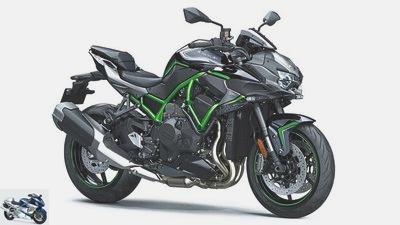
Kawasaki.
Kawasaki Z H2.
With the compressor-fired Z H2, Kawasaki is expanding its H2 range and entering the class of 200 hp naked bikes. Does this performance make sense away from the racetrack or is it just gaga? Everyone has to answer this question for themselves. In any case, more important than the top-end power is the way in which the engine serves the power – on country roads, it is best nice and powerful from below and with a steady course. The supercharged Thousand is made for this, especially since the Greens have tuned the Z for more punch in the lower speed range. Except for the swing arm (ZX-10 R) it is also based on the chassis on the previous H2 models, which can be seen at first glance from the bright green tubular space frame. The design of the front is certainly a matter of taste, but the naked bike looks angry and angry in a Kawa-like manner. It sucks in its fresh air through a mighty, single throat on the left at the level of the headlights; the lush muffler sits on the right at the back. No question about it, overall, the Z H2 makes you look macho.
Kawasaki Ninja H2 / Carbon
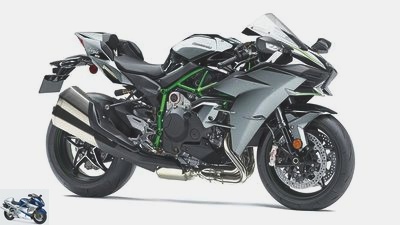
Kawasaki.
Kawasaki Ninja H2.
The exotic, half-disguised racer runs under the Supersport category at Kawasaki and is already in its fifth year in 2020. The compressor-fired four-cylinder has been producing a hefty 231 hp since 2018, making it the most powerful production bike on the planet. Its angular-pointed shapes, the sweeping cladding and the striking exhaust make the H2, let’s say, unique. There are two versions to choose from: standard and carbon. The latter differs from the former in that it has a front panel made of visible carbon.
Kawasaki Ninja H2 SX / SE / SE+
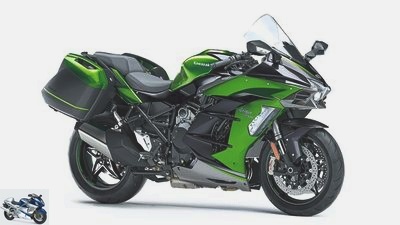
Kawasaki.
Kawasaki Ninja H2 SX SE.
The H2 SX / SE and SE + form the sport touring variants of the H2 series. Whereby the SX provides the basic tourer; The SE is more extensively equipped, and the SE + also includes the KECS semi-active chassis. If you can still argue about the futuristic design of the three versions, the objective driving characteristics do not allow two opinions. They sport tours very confident and balanced, are sociable and combine performance, speed, sport and comfort in an impressive way.
Kawasaki Ninja ZX-10R KRT Replica / SE / RR
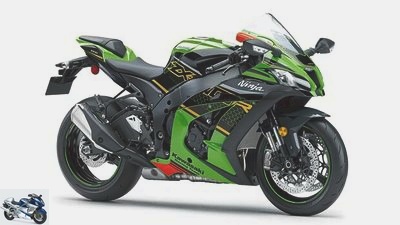
Kawasaki.
Kawasaki Ninja ZX-10R.
Kawasaki has won the World Superbike Championship an unbelievable five times in a row with the ZX-10 RR. The KRT replica rightly bears the model name in huge gold letters on the tank and side panel. The bike, however, is the standard machine and not the RR version, which forms the basis for the World Cup racer. Main differences: Instead of conventional steel connecting rods, the RR uses light titanium counterparts, which means an additional power of exactly one hp (204 to 203 hp). In addition, the expensive premium variant is limited to 500 copies worldwide. Both have in common the valve control that has been changed since 2019. At that time, the manufacturer switched from bucket tappets to rocker arms with more speed. The SE complements the series as a third variant. A semi-active chassis is used in it, the engine corresponds to that of the standard tens. The primary virtues of the series include its unshakable driving stability and top brakes. And of course the world champion image also counts.
Kawasaki Versys 1000 / SE / Grand Tourer

Kawasaki.
Kawasaki Versys 1000.
For the 2019 model, Kawasaki has given the Adventure Tourer modern electronics, but it will roll into the next year without any technical changes. With the basic Versys, the SE and the Grand Tourer, the manufacturer continues to have three variants in its portfolio, which differ primarily in their equipment. Compared to the competition, the Versys series pleases with its high level of smoothness of the inline four-cylinder, a comparatively light-footed handling, the comfortable seating position for driver and front passenger, good wind protection, reasonable consumption and decent range. And the whole package is also available at an attractive price. Over the years – the Versys first rolled out to dealers in 2012 – the Versys turned more and more into a travel machine. The actual brand essence, the proverbial Kawasaki sportiness, took a back seat. For the big tour, also with pillion passengers and luggage, the Grand Tourer is ideal. The capacity of his luggage system is huge.
Kawasaki Ninja 1000 SX
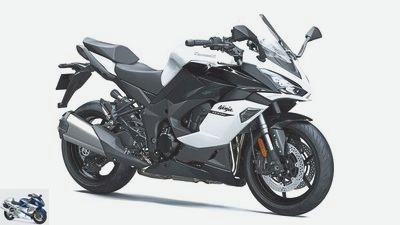
Kawasaki.
Kawasaki Ninja 1000 SX.
Instead of the Z 1000 SX, Kawasaki is now calling its sports tourer Ninja 1000 SX, giving it more sportiness. Because the term “ninja” has always stood for sporty, disguised Kawasaki models. A single exhaust replaces the previous double pipe system, and a more dynamic cladding underscores the style of the new spirit. Now in its fourth generation, the Japanese have given the sports tourer a complete LED lighting system, a more comfortable seat for driver and front passenger, a 4.3-inch TFT display including connectivity function, cruise control and four driving modes. In addition, an automatic gearshift including a blipper function has recently become part of the standard equipment. Instead of the much-criticized original equipment manufacturer Bridgestone S 20 in special specification N, Kawa now relies on the new Hypersport tire S 22 from the same manufacturer. This should significantly improve the previously somewhat inhomogeneous driving behavior of the SX. The top performance should continue to be 142 hp.
Kawasaki Z 1000 / R Edition
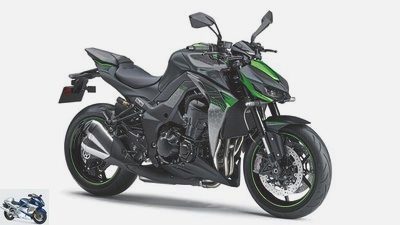
Kawasaki.
Kawasaki Z 1000.
In 2020, the cult-nasty naked bike will be back with the standard version and the R edition. The differences concern the equipment, on the R with Brembo M50 monoblock brake calipers and the Ohlins shock absorber there are more valuable components. It is also adorned with a two-tone paintwork. For the R Edition, Kawasaki calls for 1,500 euros more than for the black and gray standard Zett. The Z 900 rivals both of them in-house, but the nastier appearance is clearly provided by the significantly stronger thousands.
Kawasaki ZZR 1400
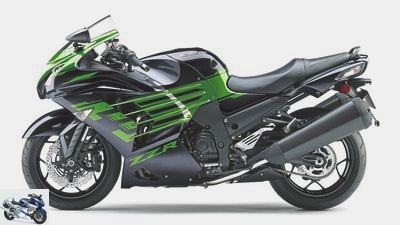
Kawasaki.
Kawasaki ZZR 1400.
Since Suzuki took the Hayabusa out of its range in 2017, Kawasaki has been making the last real speed bike with the evergreen ZZR 1400. Sure, superbikes also run 300. But they offer neither the comfort nor the wind protection of the 1400s at high speed. Competing with the ZZR are the company’s own compressor-fired H2 models. Their futuristic design, however, does not suit everyone’s taste. In addition, Kawasaki calls a few thousand less for the ZZR than for the cheapest H2.
Kawasaki in model year 2020 – prices
| model | Prices | A2-compatible? |
|---|---|---|
| Kawasaki Ninja 125 | from 4,295 euros | Yes |
| Kawasaki Z 125 | from 3,995 euros | Yes |
| Kawasaki J 125 | from 4,745 euros | Yes |
| Kawasaki J 300 | from 5,695 euros | Yes |
| Kawasaki Versys-X 300 | from 5,795 euros | Yes |
| Kawasaki Ninja 400 | from 6,295 euros | Yes |
| Kawasaki Z 400 | from 5,695 euros | Yes |
| Kawasaki Ninja ZX-6R | from 11,695 euros | no |
| Kawasaki Ninja ZX-6R KRT | from 11,895 euros | no |
| Kawasaki Ninja 650 | from 7,495 euros | Yes |
| Kawasaki Z 650 | from 6,995 euros | Yes |
| Kawasaki Versys 650 | from 8,145 euros | Yes |
| Kawasaki Vulcan S. | from 7,745 euros | Yes |
| Kawasaki W 800 | from 9,995 euros | Yes |
| Kawasaki W 800 Street | from 9,795 euros | Yes |
| Kawasaki W 800 Cafe | from 10,595 euros | Yes |
| Kawasaki Z 900 | from 9,495 euros | no |
| Kawasaki Z 900 “70 kW” | from 9,495 euros | Yes |
| Kawasaki Z 900 RS | from 11,695 euros | no |
| Kawasaki Z 900 RS Cafe | from 12,295 euros | no |
| Kawasaki Z H2 | from 17,095 euros | no |
| Kawasaki Ninja H2 | from 29,500 euros | no |
| Kawasaki Ninja H2 Carbon | from 32,500 euros | no |
| Kawasaki Ninja H2 SX | from 18,995 euros | no |
| Kawasaki Ninja H2 SX SE | from 22,095 euros | no |
| Kawasaki Ninja H2 SX SE+ | from 25,195 euros | no |
| Kawasaki Ninja ZX-10R KRT Replica | from 17,695 euros | no |
| Kawasaki Ninja ZX-10R SE | from 22,995 euros | no |
| Kawasaki Ninja ZX-10R RR | from 25,995 euros | no |
| Kawasaki Versys 1000 | from 13,095 euros | no |
| Kawasaki Versys 1000 SE | from 16,595 euros | no |
| Kawasaki Versys 1000 Grand Tourer | from 15,545 euros | no |
| Kawasaki Ninja 1000 SX | from 13,745 euros | no |
| Kawasaki Z 1000 | from 12,595 euros | no |
| Kawasaki Z 1000 R Edition | from 14,095 euros | no |
| Kawasaki ZZR 1400 | from 16,395 euros | no |
Related articles
-
New items 2019 Top topic manufacturer 29 pictures manufacturer 1/29 Kawasaki Ninja H2 costs from 29,900 euros in the 2019 model year. manufacturer 2/29…
-
Suzuki. 13th pictures Suzuki. 1/13 Suzuki GSX-R 125. Price: from 4,690 euros. Suzuki. 2/13 Suzuki GSX-S 125. Price: from 4,190 euros. Suzuki. 3/13 Suzuki…
-
Kawasaki W800 model year 2021: New color
News 2022 New motorcycle items for 2022 Kawasaki 7th pictures Kawasaki 1/7 Kawasaki is thinning out its W800 range for model year 2021. Kawasaki 2/7 Only…
-
Husqvarna in the 2020 model year
Husqvarna. 6th pictures Husqvarna. 1/6 Husqvarna Svartpilen 401. Price: from 5,450 euros. Husqvarna. 2/6 Husqvarna Vitpilen 401. Price: from 5,450 euros….
-
Honda in model year 2020 (all models and prices)
Honda. 35 pictures Honda 1/35 Honda CRF 250 L. Price: 5,600 euros. Honda 2/35 Honda CRF 250 Rally. Price: 6,500 euros. Honda. 3/35 Honda CB 300 R. Price:…
-
Ducati in the 2020 model year – all models and prices
Ducati. 20th pictures Ducati. 1/20 Ducati Scrambler Sixty2. Price: from 7,790 euros. Ducati. 2/20 Ducati Monster 797. Price: from 8,990 euros. Ducati….
-
Kawasaki in model year 2018 – colors and prices
Photo: Kawasaki 41 pictures Kawasaki 1/41 Kawasaki ZX-10R (Lime Green, KRT Replica): 17,695 euros. Kawasaki 2/41 Kawasaki ZX-10 RR (Flat Ebony): 19,995…
-
BMW Motorrad in the 2020 model year
Topic special Everything about BMW Motorrad BMW motorcycle. 29 pictures BMW motorcycle 1/29 BMW G 310 GS. Price: from 6,050 euros. BMW motorcycle 2/29…
-
Moto Guzzi in the 2020 model year
Moto Guzzi. 15th pictures Moto Guzzi. 1/15 Moto Guzzi V85 TT. Price: from 11,990 euros. Moto Guzzi. 2/15 Moto Guzzi V85 TT Travel. Price: from 13,490…
-
Triumph in the 2020 model year: Reduced prices from July 1st
triumph. 23 pictures triumph. 1/23 Triumph Daytona Moto2 765. Price: from 19,250 euros. triumph. 2/23 Triumph Street Triple S (A2 version). Price: from…